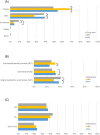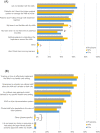Clinician knowledge and behaviors related to the 4Ms framework of Age-Friendly Health Systems
- PMID: 34837381
- PMCID: PMC9299469
- DOI: 10.1111/jgs.17571
Clinician knowledge and behaviors related to the 4Ms framework of Age-Friendly Health Systems
Abstract
Background: The Age-Friendly Health Systems (AFHS) aims to improve the experience of care for adults aged 65 years and older through the 4Ms framework, an evidence-based approach to care planning that emphasizes what matters most to the older person, mentation, mobility, and medication. The aim of this study was to examine clinicians' attitudes, knowledge, and practices concerning AFHS and the 4Ms.
Methods: We surveyed U.S.-based health care providers randomly identified from the Medscape database. The sample was weighted based on sex, U.S. Census region, and ethnic diversity of health occupations. We examined the differences between cohorts using proportions tests and logistic regression models.
Results: More than 90% of clinicians (n = 1684) agreed that "older patients require a different approach to care than younger patients." Fifty percent of clinicians "always" take the age of their patient into consideration when determining care. A majority of clinicians said they discuss each of the 4Ms with older patients and/or their family caregivers. Screening for depression and review of high-risk medication use are among the leading types of age-friendly care that clinicians provide to older patients. A minority of clinicians are asking older adults about and aligning the care plan with What Matters.
Conclusions: A majority of clinicians acknowledged the benefits of providing care via AFHS but reported limited knowledge of the specificities of the 4Ms framework and are not necessarily taking the age of their patients into consideration when determining the best form of care. Health care settings that have implemented the 4Ms framework appear to be doing so in an incomplete way. Our study reinforces the case for training primary care providers on how to adopt the evidence-based 4Ms framework in clinical practice effectively and consistently.
Keywords: 4Ms framework; Age-Friendly Health Systems; health care.
© 2021 The Authors. Journal of the American Geriatrics Society published by Wiley Periodicals LLC on behalf of The American Geriatrics Society.
Conflict of interest statement
The authors have no conflicts. Two of the co‐authors (MRE and TF) work for The John A. Harford Foundation. Four of the co‐authors (SL, SZ, CL, and JW) work for WebMD.
Figures



Comment in
-
Oral health is an integral component of age-friendly care.J Am Geriatr Soc. 2022 Aug;70(8):2442-2444. doi: 10.1111/jgs.17834. Epub 2022 May 10. J Am Geriatr Soc. 2022. PMID: 35535666 No abstract available.
References
-
- National Center for Health Statistics . Percentage of Having a Doctor Visit for any Reason in the Past 12 Months for Adults Aged 18 and over, United States, 2019. National Health Interview Survey. Centers for Disease Control and Prevention; 2021.
-
- Petterson SMR, Klink K, Meyers D, Bazemore A. The State of Primary Care in the United States. A Chartbook of Facts and Statistics. Robert Graham Center; 2018.
-
- National Center for Chronic Disease Prevention and Health Promotion (U.S.). Division of Adult and Community Health . Healthy Aging at a Glance, 2015: Helping People to Live Long and Productive Lives and Enjoy a Good Quality of Life. Centers for Disease Control and Prevention; 2011:5.
-
- National Institute on Deafness and Other Communication Disorders . Quick statistics about hearing. 2021. Accessed August 20, 2021. https://www.nidcd.nih.gov/health/statistics/quick-statistics-hearing
Publication types
MeSH terms
LinkOut - more resources
Full Text Sources
Medical

